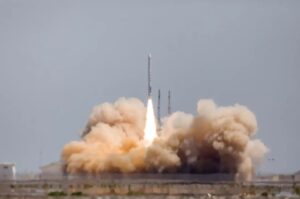China’s iSpace suffers failure with second orbital launch attempt
By Andrew Jones

HELSINKI — Launch of a Hyperbola-1 rocket by Chinese private firm iSpace ended in apparent failure shortly after liftoff from Jiuquan launch center Monday.
The Hyperbola-1 four-stage solid rocket lifted off from Jiuquan Satellite Launch Center in the Gobi Desert at around 3:00 a.m. Eastern.
The launch itself was conducted just hours after release of an airspace closure notice and with no official notice or coverage. Apparent amateur footage appeared on Chinese social media shortly after liftoff.
Later images suggest the launch had not gone according to plan. However Chinese state media had not reported on the launch more than three hours later.
A terse news report usually follows in the case of launch failures. Announcement of launch success would have followed within an hour for a similar launch into a Sun-synchronous orbit.
The launch failure comes 18 months after iSpace became the first nominally private Chinese launch company to achieve orbit with the first Hyperbola-1 rocket.
That success followed failed attempts from fellow Chinese firms Landspace and Onespace in October 2018 and March 2019 respectively.
Hyperbola-1 consists of three solid stages with a liquid-propellant fourth stage, has a length of 20.8 meters and mass at takeoff of around 31 metric tons. The launcher has three solid stages with a liquid-propellant fourth stage.
Images of the first and second Hyperbola-1 rockets suggest significant changes in design between the two launches.
Well, this one clearly didn't went in the correct direction right after launch….
China's private LSPs are perplexing easy to get to the pad and beyond, but seemingly just as difficult to get to orbit.
(https://t.co/RduRvgBOJi) pic.twitter.com/3Q50PuMtcH
— Cosmic Penguin (@Cosmic_Penguin) February 1, 2021
Last year iSpace raised $173 million in series B funding for its Hyperbola rocket series. Plans for an IPO on the Science and Technology Innovation Board (STAR Market) were revealed Jan. 12.
The Hyperbola-1 mission was China’s third launch attempt of 2021, following successful launches of the Tiantong-1 (03) communications satellite and Yaogan-31 (02) group of reconnaissance satellites in January. The Hyperbola-1 launch had been delayed from the second half of 2020.
Chinese NewSpace origins, plans
Numerous Chinese commercial space companies have emerged since a 2014 government decision to open the launch and small satellite sectors to private capital. The new companies have largely been formed by former employees of major state-owned space sector conglomerates CASC, CASIC, the Chinese Academy of Sciences and related actors.
Firms have received private investment while also in some cases being supported by state-linked investment funds. Companies have also received support in the form of policy support, assistance from giant state-owned space contractors, provincial and local government deals and Military-Civil Fusion (MCF).
MCF is a national strategy which facilitates the sharing of expertise, resources, and technologies with the aim of driving innovation, lowering costs and establishing new supply chains.
2020 saw investment of $933 million (6 billion Chinese yuan) in China’s commercial aerospace sector, up from $296 million (1.9 billion yuan) in 2019, according to Chinese data platform Tianyancha.
2021 is expected to be a big year in terms of action for China’s new commercial launch companies despite Monday’s failure.
Galactic Energy, which became only the second Chinese company to deliver a payload into orbit in November, is planning two launches of its Ceres-1 solid launcher in the second half of 2021.
OneSpace, which focuses on solid rocket rockets, is planning one suborbital and one orbital launch for the year.
Deep Blue Aerospace aims to conduct its first launch of the Nebula-1, an expendable 2.25-meter-diameter kerosene-liquid oxygen launcher, this year.
Beijing-based Landspace, established in 2015, is working towards the first flight of its Zhuque-2 (Vermillion Bird-2) liquid methane-liquid oxygen propellant medium-lift launch vehicle. Landspace performed successful fairing separation and 80-ton-thrust hot fire tests in recent days.
The Zhuque-2 and Nebula-1 are expected to be the first liquid launch vehicles launched by Chinese NewSpace companies.
Meanwhile iSpace is working on a test stage of its Hyperbola-2, another methalox launcher, for successive hop tests to altitudes in the range of meters, one kilometer and 100 kilometers this year.
Landspace has conducted a successful fairing separation test for its Zhuque-2 as the Chinese firm prepares for a test launch of the methalox rocket later in 2021. Could be the first orbital launch attempt with a methane launcher. Credit: Landspace https://t.co/mGwA1JolSb pic.twitter.com/KRmk7IHnj7
— Andrew Jones (@AJ_FI) January 28, 2021
Major year for China’s ‘national team’
China’s main space contractor, the state-owned China Aerospace Science and Technology Corp. (CASC), stated in January that it aims to launch more than 40 times in 2021. Major missions include launching a first space station module and cargo resupply and crewed missions.
Additionally, China Rocket Co. Ltd., a CASC spinoff, is preparing for launches of its Jielong-1 and larger Jielong-2 solid rockets. Expace, a spinoff from CASIC, another state-owned conglomerate and major missile maker, will conduct a number of launches of its Kuaizhou-1A and larger Kuaizhou-11 solid rockets. Plans may be affected by failures of both launchers in 2020.
CAS Space, also known as Zhongke aerospace, are also planning for a first, solid launcher orbital test mission. The company is open to outside investment but heavily backed by the Chinese Academy of Sciences (CAS), another state-owned giant involved in the space sector. CAS Space aims to develop a series of both solid and, subsequently, liquid launch vehicles, following a path taken by many new Chinese commercial outfits.
February 1, 2021 at 05:34PM
via SpaceNews read more...

Post a Comment